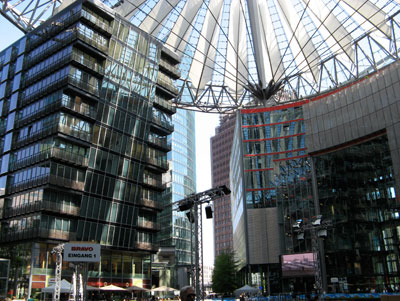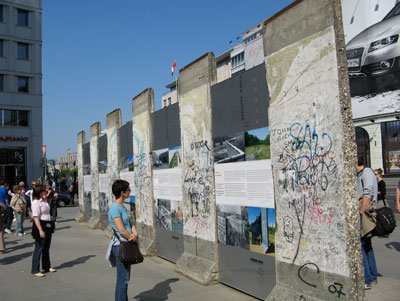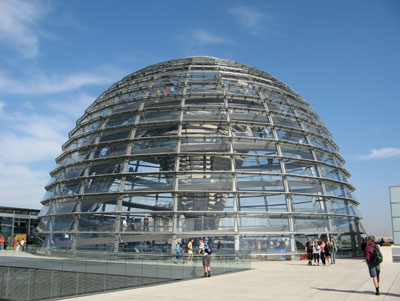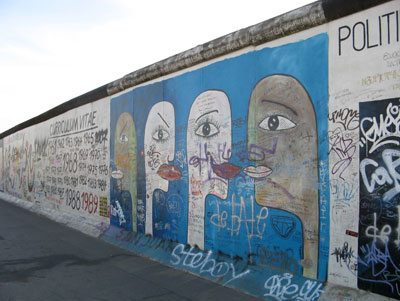Seeing reminders of the past and signs of a bright future in Berlin
by Richard Berner, San Diego, CA
2009 marked the 20th anniversary of the fall of the Berlin Wall, which divided East and West Berlin for 28 years. During those years, we witnessed many historic moments concerning the Wall, including President Kennedy giving his “Ich bin ein Berliner” speech at Rudolph-Wilde-Platz (which was renamed John-F.-Kennedy-Platz shortly after the president’s assassination) and President Reagan’s “Mr. Gorbachev, tear down this wall” delivered at the Brandenburg Gate (above) in 1987.
My wife, Martha, and I were in Germany a few years before the Wall came down and, to our regret, didn’t go to Berlin. We finally traveled there in April ’09, in part to see what remained of the Wall and to experience this reunified and reborn vibrant city.
Considering expenses
Still wanting to travel but caught in the financial doldrums of the present recession, we looked for ways to keep the cost of our trip down. We checked with American Airlines and were able to book AAdvantage award flights to Berlin through New York City and London at minimal cost to us.
We rented a modest, one-bedroom apartment in the Mitte district of the former East Berlin for €400 ($564) for a week. It exceeded our expectations. The owner, Javier Varela, is a friendly young man who has a website for the apartment (phone 011 49 30 42105742, www.my-apartment-berlin.de).
When we arrived at Tegel Airport in Berlin, we purchased week-long passes for public transportation (€26, or $37, each). The passes included rides on the subways, buses and streetcars.
There are two subway/light-rail systems in Berlin: the U-Bahn and the S-Bahn. You need to determine which line accesses the stop you want, although it’s possible to transfer between lines at most major stations.
Javier met us and showed us through the light-filled apartment at 137 Invalidenstrasse. There was an included computer for our use and WiFi available for our laptop. Our small balcony looked out on a green area, with no nearby buildings blocking our view.
Our first meal in Germany was a pizza at Papà Pane di Sorrento (Ackerstrasse 23; phone 030 28 09 27 01), located a few blocks from the apartment. With a small carafe of wine, our lunch cost €12.
REWE supermarket (158 Invalidenstrasse), our neighborhood source for groceries, was near the restaurant.
Reminders of the past
The next day, we began our explorations with a visit to Museumsinsel (Museum Island), on the Spree River, and the world-famous Egyptian collection, which contains the only known bust of Queen Nefertiti. We returned to Museumsinsel the following day to visit the Pergamon Museum and saw the wonderful, reconstructed, second-century-BC Great Pergamon Altar and the Babylonian Ishtar Gate.
Our first encounter with the Berlin Wall was at the Haus am Checkpoint Charlie museum. (Like most of the sections we saw, it was covered in grafitti.) The museum contains an interesting hodgepodge of information on the people who fled the German Democratic Republic for the West plus a history of the Wall. It included some of the vehicles and ingenious contraptions used to smuggle people across the border.
Our next sighting of a section of the Wall was at an outdoor art exhibit at Potsdamer Platz. There were several pieces, once again covered in grafitti.
The now-thriving Potsdamer Platz was previously bisected by the Wall and was described as a ghost town during the years the Wall stood. The futuristic Sony Center there, with its tent-like steel-and-fabric roof, was definitely worth a visit.
The longest remaining section of the Wall comprises the East Side Gallery. It runs along Mühlenstrasse for almost a mile and is located a few blocks from the Ostbahnhof stop on the S-Bahn. The entire length of the wall is covered in art; some of it is quite good and all of it is interesting.
We saw another stretch of the Wall at the Berlin Wall Documentation Center (Bernauer Strasse 111). This block-long section was only a short walk from our apartment and the Nordbahnhof. This is the only part of the wall that still contains the former “death strip,” the no-man’s land along the Wall.
This segment has been attacked by souvenir hunters, or “wall-peckers” as they are called. They have chipped away so much of the Wall that the metal rebar shows through in many places.
While walking through Berlin, we would occasionally see a row of double cobblestones set in the road that showed where the Wall once stood. We first noticed this directly in front of the Brandenburg Gate.
More city sights
During our week in Berlin we visited many other sights. One of our favorites was the historic German Parliament building, the Reichstag. The modern glass dome on top, designed by Sir Norman Foster, offers a wonderful view over Berlin and the Tiergarten as you walk up its interior ramp. The Tiergarten is the Central Park of Berlin, a 500-acre green belt in the center of the city.
Near the Reichstag is the Brandenburg Gate. This last remaining gate of Berlin’s old city wall was the site of JFK’s famous speech and of the iconic photos of celebrating Berliners tearing down the Wall in 1989.
East of the gate is East Germany’s most renowned boulevard, Unter den Linden (UdL). We walked along this beautiful street from the Brandenburg Gate to Museumsinsel, following descriptions from Rick Steves’ book.
We stopped for lunch at Jedermann (UdL 12), where we shared Kartoffelsuppe (potato soup) and salad for €18.
We were very impressed with and spent several hours at the German Historical Museum (2 UdL). An enjoyable break for our feet was a two-hour cruise on the Spree River, departing from Museumsinsel.
Notable neighborhoods
Berlin is a city of many interesting neighborhoods, and we enjoyed visiting several of them. Scheunenviertel, or the Barn Quarter, containted a large Jewish population prior to WWII. Now it is an area of upscale galleries, cafés and restaurants. We went through the small museum (admission, €2) in the Neue Synagogue there (28 Oranienburger Strasse).
Prenzlauer Berg is known for its nightlife and slightly alternative vibe. We enjoyed a relaxing glass of wine on one of its most attractive squares, Kollwitzplatz.
Alexanderplatz, with its dominating TV tower, was the business center of the former East Berlin. Next to it is the oldest area in Berlin, Nikolaiviertel, with its church, Nikolaikirche, dating from the 1200s.
Kreuzberg is home to the majority of Berlin’s large Turkish population and it has many inexpensive ethnic restaurants. Berlin’s excellent Jewish Museum is also located in Kreuzberg (Lindenstrasse 9-14), as is Checkpoint Charlie.
A restaurant that we would recommend in our apartment area is Honigmond (Borsigstrasse 28; phone 49 30 28 44 55). Our dinner for two with wine cost €30 ($42).
We had a delightful lunch with German friends on the patio at Café Wintergarten im Literaturhaus (Fahenstrasse 23), just off the Ku’damm. Lunches ranged from €7 for a sandwich to €15 for an entrée.
The Ku’damm, or Kurfürstendamm, is one of western Berlin’s main business streets, with many elegant shops and cafés.
A few final words
We found Berlin to be a city very easy to navigate. Many of the places we visited were within walking distance of each other.
The majority of the population speaks English, especially at tourist sites, and the people were friendly and helpful.
ATMs dispensing euros were plentiful.
We carried the compact Eyewitness “Top 10 Berlin” guidebook as well as the Berlin section of “Rick Steves’ Germany 2009,” and they provided us with all the information and maps we needed.





